Mar 24, 2011 | theater
 “How many white men does it take to change a light bulb?”
“How many white men does it take to change a light bulb?”
The second act of Bruce Norris’ new play Clybourne Park is sprinkled with this kind of would-be offensive humor, showing how the innate racism within everyone can be covered up in the context of a joke. Which is really how the entire play functions, with Bruce Norris’ insanely clever writing and the actor’s hilarious delivery of lines making the audience laugh their way through this intense social commentary.
The play is performed in two acts, one in 1959 and the second in 2009, and each one juxtaposes the other perfectly, proving that it’s going to take a lot longer than fifty years for racism to disappear because the same issues and dialogue are still around. In the first act it’s pointed out that the black couple can’t ski, and in the second, the wife laughs at the idea of her white husband trying. And both revolve around the attempt to stop the other race from infiltrating ‘their’ neighborhood, in 1959 it was the blacks and in 2009 the whites, both acts echoing the same quote, “You can’t live in a principle.” Norris’ writing is what made the play so powerful, but it was the acting that made it a riot.
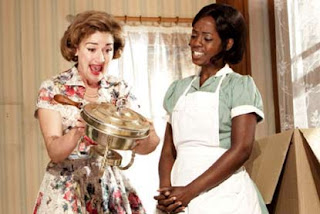 The entire first act was performed under a shade of irony, with every character exuding a ‘Hi neighbor!’ characteristic indicative of what everyone thinks the fifty’s were like—according to I Love Lucy at least. Sophie Thompson as the wife Bev took the first act by storm, with her hilariously forceful voice and adorable naivety making her the most entertaining on the stage. But Sam Spruell who played the ever-so-helpful pastor Jim never once let his ridiculous smile fall, irony dripping from his mouth every time he spoke. But only Stuart McQuarrie as Bev’s husband Russ seemed like he could have actually existed, the sadness over the loss of his son pushing him away from the happy-go-lucky attitude of his wife and neighbors.
The entire first act was performed under a shade of irony, with every character exuding a ‘Hi neighbor!’ characteristic indicative of what everyone thinks the fifty’s were like—according to I Love Lucy at least. Sophie Thompson as the wife Bev took the first act by storm, with her hilariously forceful voice and adorable naivety making her the most entertaining on the stage. But Sam Spruell who played the ever-so-helpful pastor Jim never once let his ridiculous smile fall, irony dripping from his mouth every time he spoke. But only Stuart McQuarrie as Bev’s husband Russ seemed like he could have actually existed, the sadness over the loss of his son pushing him away from the happy-go-lucky attitude of his wife and neighbors.
With the changing of the acts came the complete reversal of the set, the once beautiful home now dilapidated and crumbling. And conducive to Norris’ echoing theme, the same actors played their 50-years-later counterparts, giving those with the quieter parts in the first act a chance to yell and scream and get offended. Which is exactly what happened as the tiptoe dance of political correctness pushed everyone to the edge. Sarah Goldberg as the pregnant wife Lindsey dominated the second act with her exclamations of “Half of my friends are black!” and “Well that was insulting,” her character serving as I’m-not-racist angel on everyone’s shoulder that whispers, ‘You better not tell that joke.’ But no matter how hard Lindsey tries to excuse her husband’s behavior, it is his bluntness that reveals the brilliantly made point of Clybourne Park: that the current obsession with political correctness doesn’t really make anybody colorblind.
Oh, and it takes one white man to hold the light bulb while the rest of them screw the entire world. Please don’t be offended.
GD Star Rating
loading...
Mar 7, 2013 | design
When you’re a kid, a treehouse is the one place where grownups aren’t in charge. If you’re a girl it’s no boys allowed and vice versa. Only those deemed trustworthy are allowed up to the sacred space so that everyone can feel safe enough to discuss their hopes for the future – even if that only includes trying to get out of going to school tomorrow.
But treehouses become more than that when Kobayahsi Takashi makes them – a professional treehouse architect, he’s traveled around Japan and the world creating miniature spaces high up in the branches, brought to life by the fact that the very thing supporting them is alive. He writes, “…everywhere I’ve been, I’ve seen reflected in these largest and oldest of living beings the same nameless light that I’ve struggled to maintain within myself for so many years, the one that no one could tarnish and that never seemed to disappear. That comfort, that sense of calm, is something I’d like to share with as many people as possible. And it is with that in mind that I will continue with the one-of-a-kind rush that is treehouse creation, all the while carrying out my own personal dialogue with their hosts.”

Takashi is a member of the Tree People, both a company and organization that stands with trees and builds off them. Their website reads, “We who build these structures are not architects; our aim rather, through art and free expression, is to break down the feeling of separation that exists between humans and nature.”
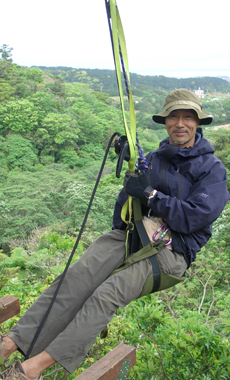
Kobayahsi Takashi
I especially love this glass treehouse nestled in an Okinawa forest – just a little dome that transforms people into birds, letting them soar up high in the branches; plenty of windows for fresh air and with opening at the top towards the sky. This photograph was taken at just the right angle too – its obvious why they selected this tree as each side of its arms open wide, embracing and balancing the little glass dome held within.
See more Tree People treehouses in their online gallery.
Takashi also wrote a book called “Treedom” if you’re interested.
GD Star Rating
loading...
Feb 26, 2013 | sculpture
Peter Callesen uses paper itself as a medium, carefully cutting away forms and shapes from a sheet of backdrop, then reconstructing those fallen bits into miniature sculptures that are sometimes still connected to the flat blank paper they used to be, almost as if they were falling out of place. These simple delicate masterpieces combine two-dimensional shapes with three-dimensional sculptures, now affected by gravity and casually laying upon the wooden frame’s platform.
In “Dead Angels” this is exactly the case, winged skeletons falling from the cutout silhouettes of flying angels. The concept behind trace and form lends itself to this duality of ideas – the lack of paper inside the angels’ forms indicate their absence, accounted for by the three skeletons only held up by the paper’s thick wooden frame, their wings still attached but useless. I especially love the third skeleton, hanging by one big toe to the angel he used to be as his body leans upside-down, but in a silly way, arms outstretched as if to say ‘oh well.’
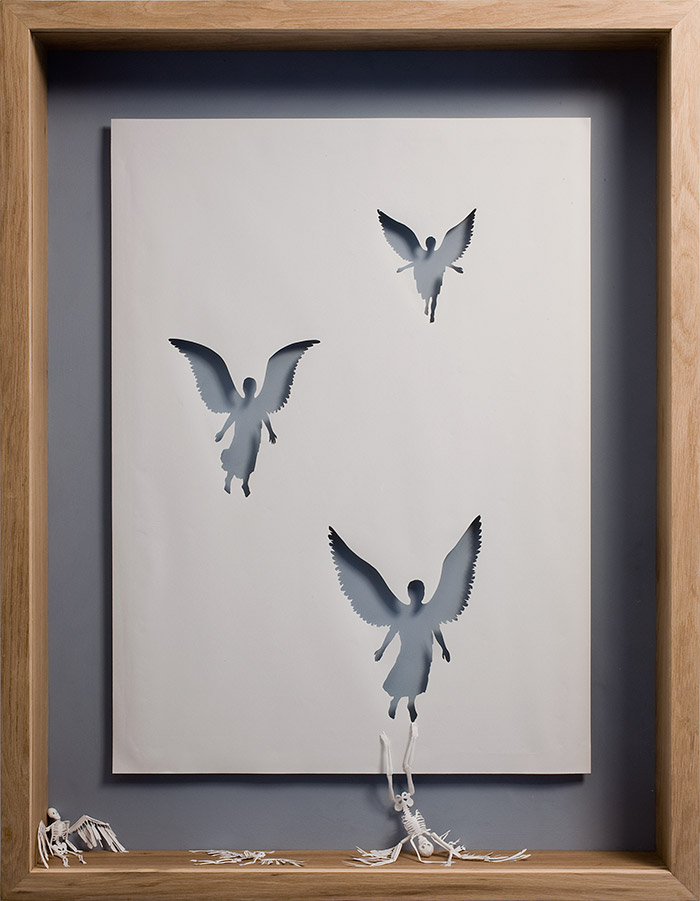
Dead Angels, 2007
Acid Free paper, glue, acrylic paint, and oak frame.
127 x 94 x 11,5 cm.
“City of Homeless Thoughts” visualizes its title metaphorically, the intricately cut profile view of a head is filled with interlocked tubes and wiring that branch outside his form, cast above the frame litered with miniature paper houses.
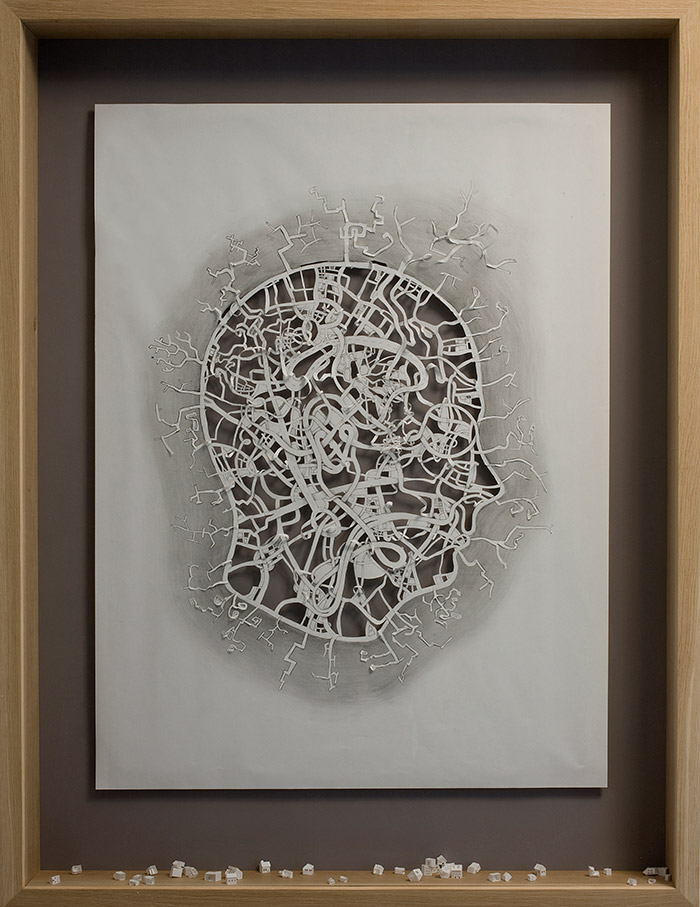
City of Homeless Thoughts , 2008
Acrylic paint, on 120 gsm acid free paper, pencil and oak frame.
139 x 106 x 13 cm.
“Cut to the Bone II” is the funniest of them all in a dark twisted kind of way – a skeleton against a dull pink background rolls down the paper his form came from, his skeleton legs and feet still drawn inside the painted paper that’s held rolled up by his skinny little skeleton fingers at the hips.
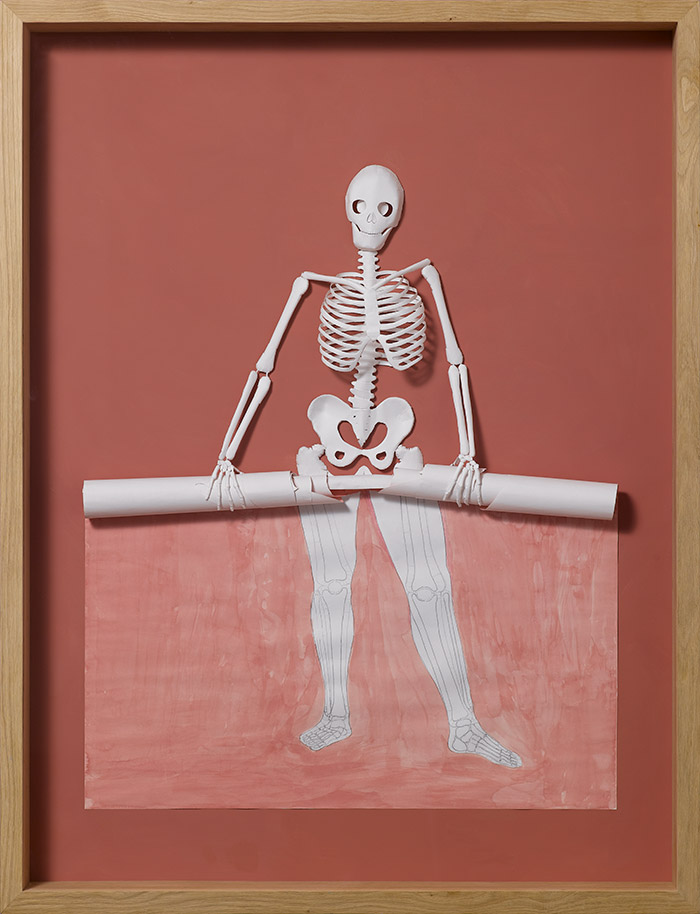
Cut To The Bone II, 2008
Watercolor and pencil on 120 gsm acid free paper, glue, and oak frame.
139 x 107 x 13 cm.
“The Roots of Heaven” shows a poetic detail of a tree too symmetrical to be real, its cut out form laying on the frame, still connecting and now visually serving as the tree’s roots, linking it to its past.
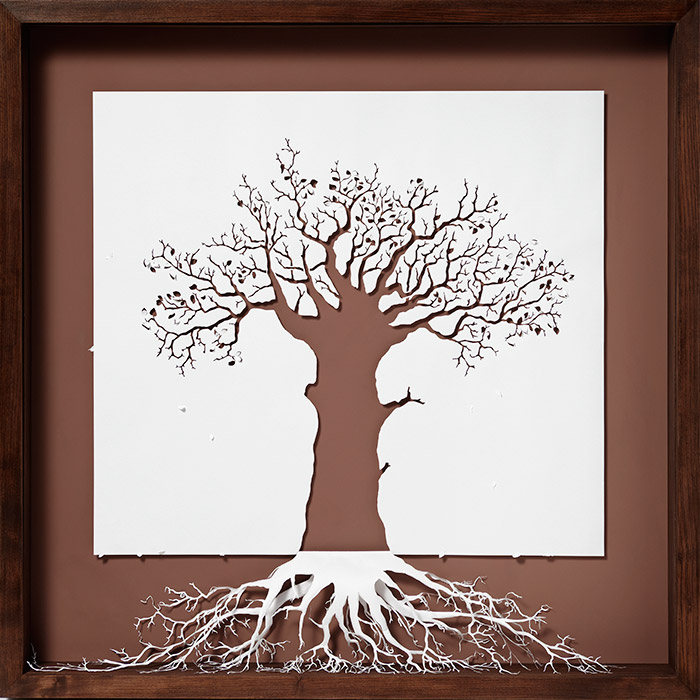
The Roots of Heaven, 2009
Acid-free 120 gsm paper, glue, acrylic paint and wooden frame.
107 x 107 x 13 cm
See more of Peter Callesen’s work on his website here.
GD Star Rating
loading...
 “How many white men does it take to change a light bulb?”
“How many white men does it take to change a light bulb?” The entire first act was performed under a shade of irony, with every character exuding a ‘Hi neighbor!’ characteristic indicative of what everyone thinks the fifty’s were like—according to I Love Lucy at least. Sophie Thompson as the wife Bev took the first act by storm, with her hilariously forceful voice and adorable naivety making her the most entertaining on the stage. But Sam Spruell who played the ever-so-helpful pastor Jim never once let his ridiculous smile fall, irony dripping from his mouth every time he spoke. But only Stuart McQuarrie as Bev’s husband Russ seemed like he could have actually existed, the sadness over the loss of his son pushing him away from the happy-go-lucky attitude of his wife and neighbors.
The entire first act was performed under a shade of irony, with every character exuding a ‘Hi neighbor!’ characteristic indicative of what everyone thinks the fifty’s were like—according to I Love Lucy at least. Sophie Thompson as the wife Bev took the first act by storm, with her hilariously forceful voice and adorable naivety making her the most entertaining on the stage. But Sam Spruell who played the ever-so-helpful pastor Jim never once let his ridiculous smile fall, irony dripping from his mouth every time he spoke. But only Stuart McQuarrie as Bev’s husband Russ seemed like he could have actually existed, the sadness over the loss of his son pushing him away from the happy-go-lucky attitude of his wife and neighbors.









